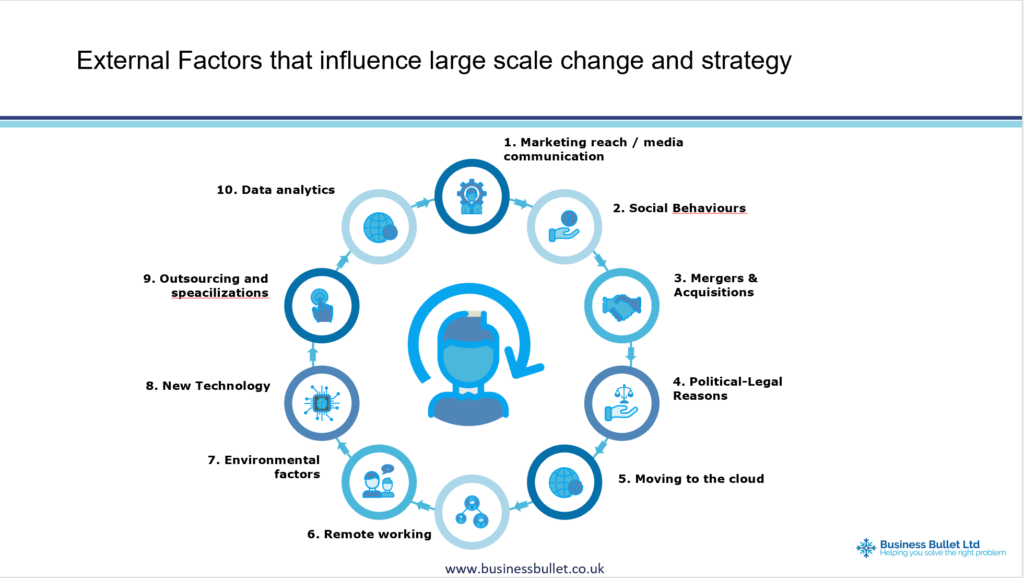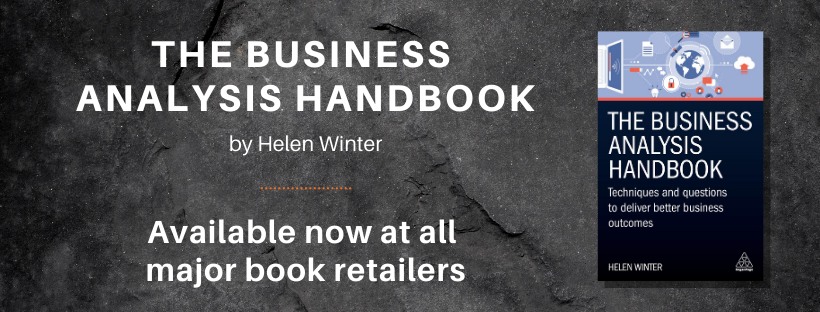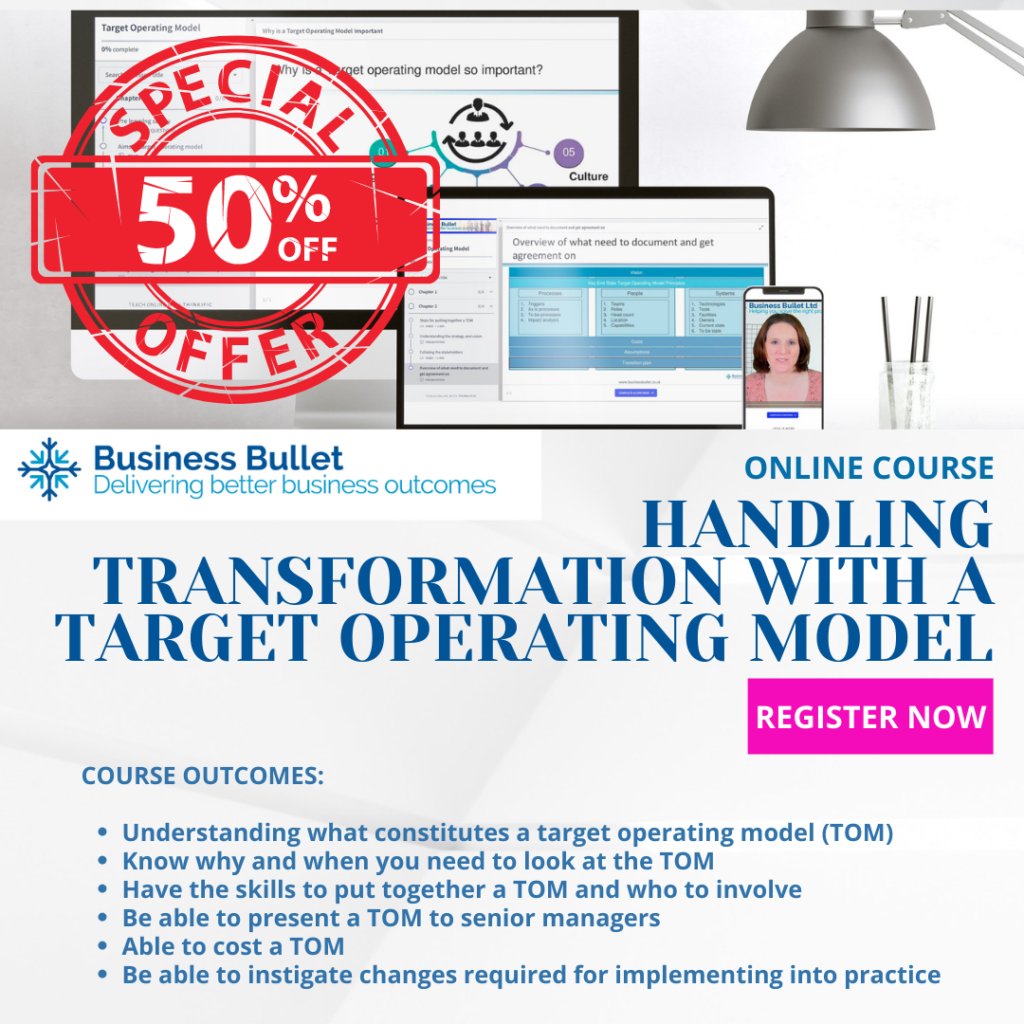
There has been so much uncertainty for many businesses over the last few years with significant changes to external factors. The slide below is from a presentation I did at the APM SIG conference on Target Operating Models.

This article looks at external factors and why companies will need to plan their target operating model to ensure they are adapting to support their company strategy into the future. External factors can cause disruptions and impact the way a company may want to operate.
1. Marketing reach / media communication
Social media has transformed how we communicate. We have blogs, forums, business networks and photo-sharing platforms to social gaming, chat apps, video sharing platforms and more. Social media means we’re communicating far more frequently and with wider audiences, locally and globally.
Social media has become much more important to people’s daily lives. In an article published by Statista the average daily social media usage was 145 minutes per day in 2020 which was an increase from the previous year. Its therefore no surprise that out of this the term Influencers has appeared. This is where a person builds up expert knowledge of a service or product and promotes it on social media. These influencers can have thousands or millions of followers.
2. Social Behaviours
Social behaviours have changed over the last few years. Evidence showed that there was more demand for products to be delivered to homes, especially bulky items. When the pandemic hit this turned into consumers desire for everything to be delivered to the home. A recent example in the insurance industry could be how they want to handle the insurance of empty offices and additional risks of people working from home. Water companies needed to look at how to cope with higher demand from people washing their hands for longer.
Research by Accenture found that consumers place importance on brands having Ethical products and demand is higher for those products that support this.
Another example of a trend that has emerged is a demand for multiple payment options and buy now pay later approaches. As a result there are now businesses dedicated to allowing other companies to provide this. Companies can benefit hugely by looking at new trends and adapting their strategy and target operating model to support it.
3. Mergers and Acquisitions
According to PWC – Global M&A Industry Trends global mergers and acquisitions (M&A) hit new highs in 2021. Deals announced exceeded 62,000 globally in 2021 which was 24% higher than from 2020. This helped some companies to be able to transform their business models with new capabilities by merging with a company that already had the capability they wanted.
4. Political Legal Reasons
This could include new regulations. Industries such as the finance and insurance sector have to ensure they constantly keep up to date with regulations from the finance conduct authority and often new regulations from Europe.
5. Moving to the Cloud
I have included this separately to new technology as it is a huge influence in its own right. Expectations have grown hugely and is less than two decades old. Cloud technology has changed the way products are delivered, with cloud-based software quickly becoming the norm.
6. Remote Working
Covid has led to more remote working and changed how companies want to organise themselves. Having been involved with building teams myself over the last couple of years there has been less of a concern to recruit locally to the office and more emphasis has been on finding the best fit with little concern as to where they are based. I now have people working in very different places and across different countries. Many roles are now advertised as remote working. Companies have seen this as an opportunity to recruit where the best talent is and to save costs on office space. This shows that people and location are impacted which are both part of a companies operating model.
Technology also must support remote working. Many companies have moved to cloud which do not rely on staff having to maintain servers on site. They can then make sure you have the right toolset without physically needing access to your machine. If this capability is not possible then technology will need to be revisited. There may be additional software required to support remote working. In recent years collaboration software like Teams, Skype and Zoom are becoming more of a necessity. Company processes and policies will need to keep up to speed on what should be adopted.
7. Environmental factors
Companies are facing pressure by the government to be more eco friendly by encouraging them to report on their energy use and greenhouse gas emissions. This could lead to a strategic impact to consider climate change factors such as using less plastic, greener energies and travel distances.
8. New Technology
Technology progression means there are new ways of doing things with more opportunities for automation and use of artificial intelligence. There have also been an emergence of companies that have appeared who have focussed on innovation, using existing technology but to deliver services in a different way. Uber, Amazon, Deliveroo, Netflix, Airbnb are some of these companies who have emerged in the last 10 years with different business models to traditional companies.
9. Outsourcing and Specialisations
Equally companies are outsourcing to cover areas outside their expertise.
10. Data Analytics
Technology and data is now available to enable predictive analytics to design great customer experiences (McKinsey & Company. 2021). This is will help firms focus on what will sell in future years. Using data to understand why something has happened will perhaps enable a company to do better in the future. This can also be taken a step further to what is known as prescriptive analytics (Harvard Business School) which works out what the next best actions are based on data.
Essentially it can be used to get better customer insights and to help make better decisions.
Conclusion
It is important plan a target operating model for the future to cater for how the company wishes to grow. This means insuring that a company’s processes, people and technology are supporting the company strategy. As outlined above there have been many recent changes. This is likely to mean that a company will be looking at their strategy and wanting to ensure their operating model continues to add value.
Thoughts? Questions? Please share in the comments.
*****If you are interested in learning more about Target Operating Models you could sign up to join my online training course on it which launches on 23rd May. You can sign up now for a 50% discount – Handling Transformation using a Target Operating Model.
If you have found this article useful then you might like my book – The Business Analysis Handbook – Techniques and Questions for better Business Outcomes. The book is available from www.koganpage.com and all major print and e-book retailers.

References
Statista Research Department. 2021. Daily social media usage. Available: https://www.statista.com/statistics/433871/daily-social-media-usage-worldwide [2021, Dec 30].
Influencer marketing hub, 2021. Influencer Rates: How Much do Influencers Really Cost in 2022? Available: https://influencermarketinghub.com[2021 Dec 30]
Accenture. 2018. From me to we: The rise of the purpose-led brand. Available: https:www.accenture.com/gb-en/insights/strategy/brandpurpose?c=strat_competitiveagilnovalue_10437228&n=mrl_1118 [2021 Dec 30]
McKinsey & Company. 2021. Prediction: The future of CX. Available: https://www.mckinsey.com/business-functions/marketing-and-sales/our-insights/prediction-the-future-of-cx [2021 Dec 30]
Harvard Business school, Catherine Cote. 2021 What is prescriptive analytics? 6 examples. Available: https://online.hbs.edu/blog/post/prescriptive-analytics [2021 Dec 30]

